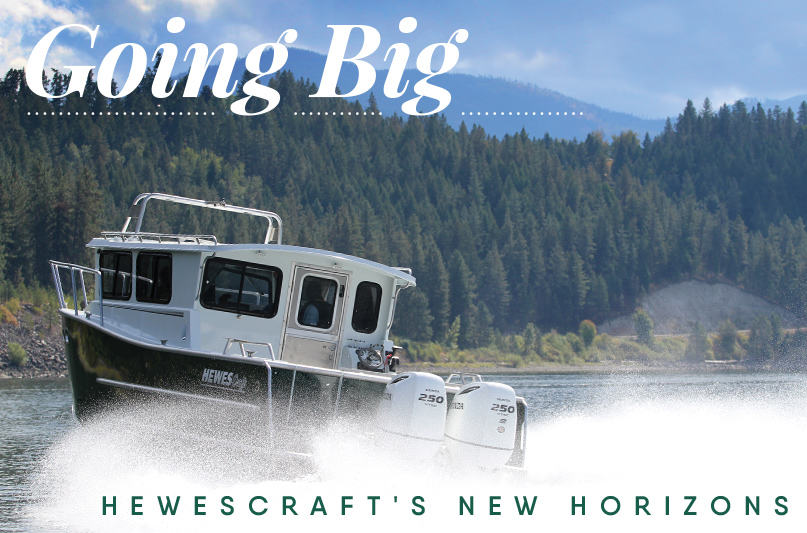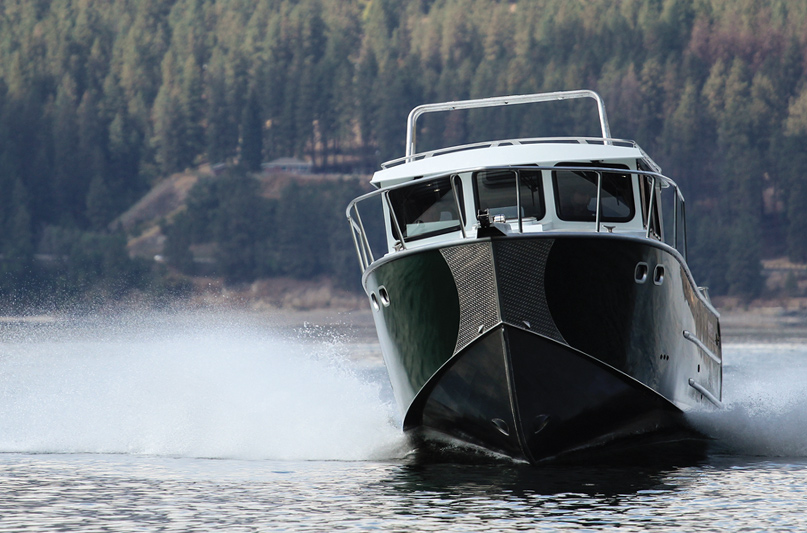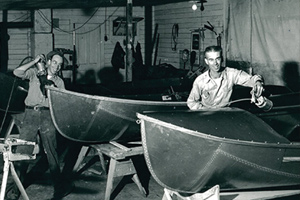
 A large tumbleweed explodes into a disparate cloud of twigs as my car, unleashed on an open country road somewhere on the Colville Reservation, passes through it. Around me are dusty pine forests, some touched by the summer wildlife season, that smell like new beginnings. A roadkill jackrabbit carcass and herd of cattle bound by barbed wire fencing go by. The shriek of a red-tailed hawk is the perfect accent.
A large tumbleweed explodes into a disparate cloud of twigs as my car, unleashed on an open country road somewhere on the Colville Reservation, passes through it. Around me are dusty pine forests, some touched by the summer wildlife season, that smell like new beginnings. A roadkill jackrabbit carcass and herd of cattle bound by barbed wire fencing go by. The shriek of a red-tailed hawk is the perfect accent.
Based on the scenery alone, one wouldn’t guess that I am nearing the factory of the largest boatbuilder by units sold in the Pacific Northwest. I’m headed east to the Wild West to visit the Hewescraft factory, specifically to get a first look at their newest and largest build, the 290 Adventure. This whole scheme was hatched many months before when I met Clint Kirry, a director and vice president at Hewes Marine Company, for the first time at a Northwest Marine Trade Association conference in Spokane, Washington. As per usual, I get schemey after a few beers, and the all-new 290 Adventure came up.
If you’ve boated long enough in the waters of Alaska south to Oregon and Washington east to Montana, you’ve undoubtedly seen a Hewescraft. Built as compact, rugged, well-performing aluminum trailerable fishing machines, Hewescraft boats have been around since 1948. Striking that golden balance of quality and affordability, these boats are aimed squarely at the couple with two kids and a dog crowd, the serious fisherfolk with buddies in tow, or those who want a reliable guide boat for their salmon fishing charter services.
Ever since the early 2000s, Hewes Marine Co. has been expanding from their traditional open, aluminum builds to a line of models built for extended cruising with enclosed cabins. Notably, the newer Alaskan and Pacific Cruiser models, while still under 30’ length overall, are clearly flirting with the new direction. The fresh-off-the-line 290 Adventure is that committed first date between Hewescraft and the 30’ cruising family. Will this blossom into a serious relationship?
These thoughts bounce about in my head like the tumbleweed I annihilated as I pull into the parking lot. The dust from my wheels settle, I shake hands with Clint Kirry again, and we’re off into the factory.
Fresh from its first boat show, hull #4 of the 290 Adventure is getting loaded onto its trailer, I am given the factory tour. Right away, Kirry lays down some photography ground rules. Generally, no cameras are allowed within.
“I’ll let you know what you can and can’t take pictures of,” Kirry says and chuckles. “We know for a fact that some of our competitors have bought and cut open our boats to learn about our building process. We don’t want to serve up our trade secrets lightly.”
The factory is a retrofitted bowling alley, and if you squint hard enough past the dozens of aluminum boats in various stages of completion, you can imagine the phantoms of the lanes and thunder of falling pins. The organization of the factory is very logical, with the raw materials on one side and completed boats on the other.

“We try to make the labor and boats flow in one direction,” says Kirry as we watch a team load sheet aluminum to be cut and formed by giant machines. “The main parts of the boats get cut here, and then the pieces are sent down the line to be welded in the next area.”
As we walk down the line, it’s apparent that this is a serious operation. I ask Kirry about the scale of the operation as we examine the leak testing tank (which all the boats go through) and stroll through the metal hulks of soon-to-be boats. Here, the larger metal components are welded together. One doesn’t have to be a professional welder to appreciate the perfect craftsmanship of the Hewescraft welders, the welded seams immaculate.
“We currently employ 160 people full-time, and most of those are in manufacturing,” says Kirry, clearly proud of Hewescraft’s commitment to the American manufacturing sector. “As far as boat volume, we produce between 18 and 19 boats per week. We are not a custom shop and don’t want to be.”
One element of building the boats that is firmly in the do-not-photograph category are their fitting frames and clamping schemes. Fiberglass companies may be territorial about their molds, and the rough equivalent of this in the aluminum boat business is the fittings.
“Aluminum is tricky, as it always wants to warp and move around,” says Kirry. “Therefore, as the boats are welded, they get clamped onto specially made fitting frames to keep them in the right form.” The methodology of these fitting frames and clamps is a Hewescraft secret.

Another feature I can’t photograph is how Hewescraft installs the floatation foam into their hulls, another point of pride for the company. The U.S. Coast Guard has stringent regulations for floatation in boats under 20’, which Hewescraft meets with all their models. However, Hewescraft opts to keep a similar flotation standard for all their builds, not just ones under 20’ in length.
“To be honest, that’s one of the most important things that really sold me on this company,” says Kirry. “That commitment to safety is huge. Just recently one of our Alaskan buyers got into some really hairy water off Kodiak and his 21′ Sea Runner capsized. He stayed with his boat as you’re supposed to do for two hours before he was able to flag down a passing ship and was rescued. The flotation saves lives and not something we skimp out on.”
We pass by two gigantic ovens, and I even enter one to look around. It’s here that the boats are painted and baked into shape within, metaphorically entering as clumps of dough and leaving fully formed cookies. After the heat treatment of the oven, the nearly complete boats go down the last stretch of the line where things like electric systems are installed.
Our time in the factory ends just as the Hewescraft 290 Adventure is ready for action. Looming large and green, hull #4 is fitted with twin Honda 250-horsepower engines and sits comfortably on her trailer. Twin 300-horsepower Yamahas are also options for the 290 Adventure, and in the future, inboard diesel options are something the company is considering.
“We have a deal with EZ Loader trailers, built in nearby Spokane,” says Kirry. “They are a good fit for our boats.” While built to be trailerable, it is an oversize load and law stipulates appropriate signage be posted for drivers. The first impression is of a rugged sport boat, a look reinforced by the large fishing-oriented cockpit complete with live bait well, fishbox, and studded aluminum floor. The forward attack angle of the wheelhouse is also that of a no-nonsense Pacific Northwest open water fishing machine. In no time we’re underway and the boat is launched into Lake Roosevelt for a test spin.
Once underway, I get a proper look at the interior. Spacious with hickory and mahogany wood trim, the interior is where this boat differentiates itself from most of its aluminum fishing sisters. With a galley to starboard, dinette (that converts to a berth) to port, and captain and co-captain chairs forward, it’s the spacious interior of a proper motorcruiser. Travel a few steps down the companionway forward, and you’re in a large V-berth (with 6’11”-long body clearance) with en suite head. I’ll admit, I do a few double takes and remind myself: “Yep, this is a Hewescraft.”
However nice the boat is thus far, the real mind blower is the performance once I take the helm. The 290 Adventure almost seems to float over the water versus ply upon it, especially on a windless calm day like this one. I initiate a few turns over her own wake at full throttle, even some abeam, and she handles them like a champ. Even a hard stop, from wide open to zero, is so smooth that nobody needs to use the handrails (of which there are many). What’s going on?
One of the team’s staff engineers, Alex Dzinbal, is aboard and offers his thoughts. “This boat has a big, thick, 8″ chine that provides a lot of lift and stability, helping get on step at lower speeds. It helps the boat perform well.” Dzinbal also accredits the performance to the hull form.
“This boat has 21-degree deadrise in the back, and something like 55 degrees up at the bow. We keep that keel low all the way forward too. If you look at Kingfisher or North River, companies we may be competing with, they pick their keel up as you move toward the bow. It may be a good entry angle, but it’ll slam more underway in weather.”
How the 290 Adventure utilizes deadrise may be the answer to some of the smooth performing voodoo going on. “On these boats, unlike our other builds, the back third of this hull is flat constant deadrise. This helps with performance on large planing hulls.”
For Hewescraft shipping supervisor and boat driver Jim Rogers, who is also aboard, the 290 Adventure is his favorite of the whole Hewescraft lineup. “This one is my favorite to drive. The performance, the handling, it’s just great. Docking is easy with one person (bow thruster helps). This one just handles the best. Easy to tow, easy to dock, all-around good.”
The full suite of electronics on hull #4 is not operational at the time of our ride, but performance data from Hewescraft publishes a maximum speed of around 47 miles per hour at 5,900 RPM, and that sounds right to me based on my ride. The fuel efficiency at that speed is about 1 mile per gallon or 47 gallons per hour. More typically, a cruiser will probably operate in the 20-something miles per hour range for a fuel consumption in the 12 to 20 gallons per hour and 1.7 to 1.6 miles per gallon range. More specs can be found by contacting Hewescraft or on their website at hewescraft.com.
All told, driving hull #4 around Lake Roosevelt had me smiling from ear to ear.
After tucking away hull #4 on her trailer, Kirry and I part ways after some more boat talk. Turns out that hulls number 1 though 5 are built and spoken for and up to six more may be available during the upcoming 2019 model year.
“The production run proper, when we will officially roll these out assembly line style at a pace of one and maybe eventually two a month, will not begin until our 2020 model year,” Kirry says. I ask him about the future of the company. Will Hewescrafts keep getting bigger? Will the company known for building safe, reliable, and fun runabouts have more for bluewater yachties as time goes on?
“I think there’s a lot of good reasons for us to explore this market,” says Kirry. “We’ll follow the opportunity, and if the 290 Adventure does as well as I think it could, we’ll definitely be playing with bigger boats. It’s easy for me to imagine an 310 Adventure that features an extended cockpit for even more fishing capabilities.”

at around 47 miles per hour when trimmed properly.
From an industry perspective, the 290 Adventure looks like a contender in what I’m dubbing the Pacific Northwest Trailerable Pocket Cruiser Renaissance (PNTPCR? Pint Picker?) we’re going through. Recently, local builders have been churning out quality pocket cruisers that have affordability as a top consideration with massive success. Examples include Ranger Tugs and Cutwater, built in Washington, that are now ubiquitous on the water.
Anecdotally, the recent Ranger Tug rendezvous was attended by hundreds of their clients, very impressive for a company less than a decade old. The 290 Adventure is definitely a crossover of sorts, with elements of aluminum family fishing boats and more luxurious cruisers.
As far as the company’s future is concerned, a nearby factory space—once a lamp manufacturer—will soon be the new headquarters. The current Hewes Marine Company facility is 60,000 square feet with office space in modular outbuildings, while the new location has 100,000 square feet of manufacturing space with 30,000 square feet of office space included. In many ways, this factory move says it all. If the larger Hewescrafts like the 290 Adventure do become a success, they’ll need all the space they can get.
Read the full story on Issuu
